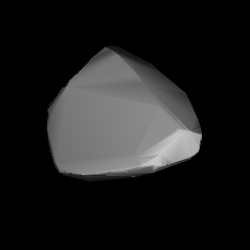
Echo is a quite large main-belt asteroid. It was discovered by James Ferguson of the United States Naval Observatory in Washington D.C., on September 14, 1860. It was his third and final asteroid discovery. It is named after Echo, a nymph in Greek mythology. James Ferguson had initially named it "Titania", not realizing that name was already used for a satellite of Uranus.

343 Ostara is a background asteroid from the inner region of the asteroid belt. It was discovered by German astronomer Max Wolf at the Heidelberg Observatory on 15 November 1892.

380 Fiducia is a dark and large asteroid, approximately 68 kilometers in diameter, located in the central region of the asteroid belt. It was discovered by French astronomer Auguste Charlois at the Nice Observatory on 8 January 1894. The carbonaceous C-type asteroid has a rotation period of 13.7 hours. It was named "Fiducia", the Latin word for confidence.

Dodona is a large Main belt asteroid that was discovered by the French astronomer Auguste Charlois on 29 January 1894 in Nice. It is classified as an M-type asteroid.

Janina is a Themistian asteroid, approximately 46 kilometers in diameter. It is spectral B-type and is probably composed of primitive carbonaceous chondritic material.

Burdigala is a typical Main belt asteroid. It was discovered by F. Courty on 11 February 1894 in Bordeaux. It was the first of his two asteroid discoveries. The other was 387 Aquitania. Burdigala is the Latin name of the city of Bordeaux.

Ilmatar is a large Main Belt asteroid.

Siegena is a very large main-belt asteroid. It is classified as a C-type asteroid and is probably composed of primitive carbonaceous material.

388 Charybdis is a very large background asteroid, approximately 125 kilometers in diameter, that is located the outer region of the asteroid belt. It was discovered by French astronomer Auguste Charlois at the Nice Observatory on 7 March 1894. The carbonaceous C-type asteroid has a rotation period of 9.5 hours. It is probably named after Charybdis, a sea monster in Greek mythology.

Alma is an asteroid from the intermediate asteroid belt, approximately 24 kilometers in diameter. It was Guillaume Bigourdan's only asteroid discovery. He discovered it on 24 March 1894 in Paris.

Wilhelmina is a large Main belt asteroid.

Lampetia is a fairly large main belt asteroid that was discovered by German astronomer Max Wolf on 4 November 1894 in Heidelberg. It has an unusually low rotation rate, with a period estimated at 38.7 hours and a brightness variation of 0.14 in magnitude.

Delia is a large Main belt asteroid. It was discovered by the French astronomer Auguste Charlois on 30 November 1894 in Nice. "Delia" is an epithet for the ancient Greco-Roman Moon goddess Artemis, for her birthplace at Delos. This asteroid is orbiting the Sun at a distance of 2.79 AU with an orbital eccentricity (ovalness) of 0.085 and a period of 4.64 yr. The orbital plane is tilted at an angle of 3.35° to the plane of the ecliptic.

Aeolia is a typical main belt asteroid. It was discovered by the French astronomer Auguste Charlois on 1 December 1894 from Nice, and may have been named for the ancient land of Aeolis. The asteroid is orbiting the Sun at a distance of 2.74 AU with a period of 4.54 years and an eccentricity (ovalness) of 0.16. The orbital plane is inclined at an angle of 2.5° to the plane of the ecliptic. This is the largest member of the eponymously named Aeolia asteroid family, a small group of asteroids with similar orbits that have an estimated age of less than 100 million years.

Nassovia is a minor planet orbiting the Sun. It is a member of the Koronis family of asteroids.
Ingwelde is a Themistian asteroid. In light of Max Wolf's practice ca. 1905 of naming his discoveries after operatic heroines, it is most likely named after the title character of Ingwelde, an opera by Max von Schillings premiered in Karlsruhe in 1894.

621 Werdandi is a Themistian asteroid.

662 Newtonia is a minor planet, specifically an asteroid orbiting mostly in the asteroid belt.
761 Brendelia is a minor planet orbiting the Sun that was discovered by German astronomer Franz Kaiser on September 8, 1913, and named after Otto Rudolf Martin Brendel. It is orbiting at a distance of 2.8619 AU from the Sun with a period of 4.842 yr and an orbital eccentricity of 0.065297. The orbital plane is inclined at an angle of 2.16° to the plane of the ecliptic.
768 Struveana is a minor planet orbiting the Sun. The asteroid was named jointly in honor of Baltic German astronomers Friedrich Georg Wilhelm von Struve, Otto Wilhelm von Struve and Karl Hermann Struve.

















